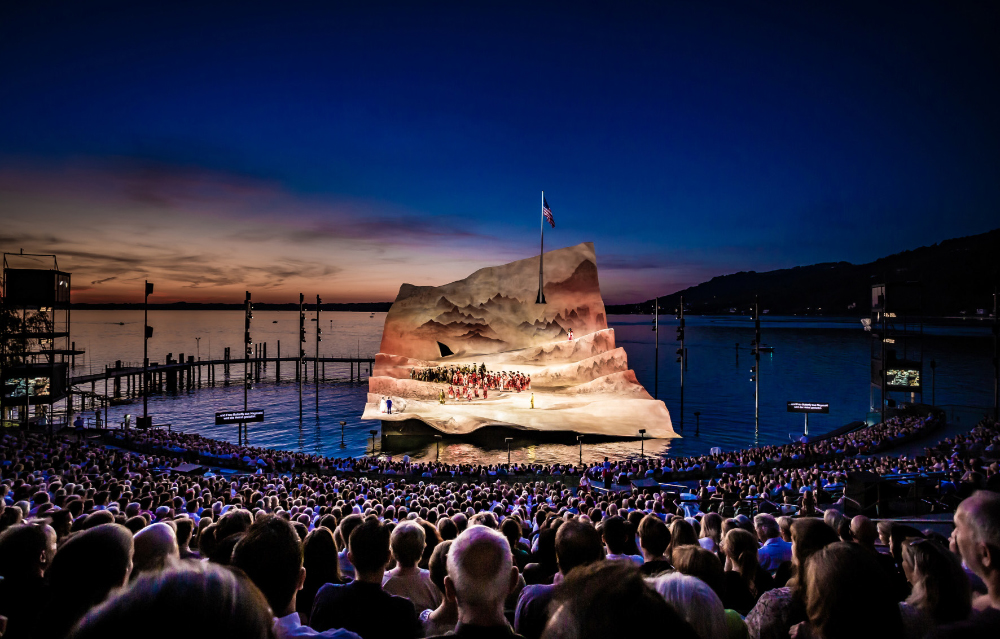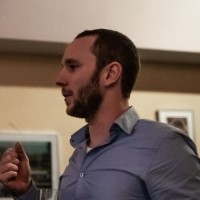For decades, the Bregenz Festival in Austria has entertained audiences with captivating open-air performances set against the backdrop of Lake Constance. Since its inception in 1946, the festival amidst nature’s splendor has been a celebration of opera on a floating stage, drawing nearly 200,000 visitors annually over five weeks.
Between 2018 and 2022, a transformation under the name of “BOA 2.0 – Bregenz Open Acoustics” revitalized the entire sound system. The revamp encompassed updates to the mixing system, room simulation, surround sound, and directional mixing. Notably, in 2021, under-seat sound reinforcement was introduced to enhance audience immersion.
The challenge lay in compensating for the absence of reflective surfaces one finds in concert halls and opera houses, a feat achieved through innovative electro-acoustic strategies that create an acoustic experience close to that of a top-notch venue. The audience has come to expect a listening experience comparable to a concert hall, while the unique atmosphere of the stage on the lake needs to be preserved.
Setting The Parameters
The dimensions of the floating stage in Bregenz are as follows. The grandstand is approximately 80 meters deep and about 90 meters wide; the width of the “portal” is around 40 meters; the smallest distance from the edge of the stage to the first row of spectators is just under 20 meters; and the grandstand has a seating capacity of 6,658.
These dimensions dictate three requirements for the sound system: first, the audience must be presented with a spatial sound experience that comes as close as possible to that of a real music theater. This is provided by means of a spatial simulation system.

Second, the audience needs to be able to acoustically locate the singers on stage. It must therefore be possible to acoustically reproduce the movements of the performers in a way that is comprehensible to the entire audience.
And third, the sound field on the floating stage needs to be suitably large and impressive, given that the size of the stage, the stage technology, the lighting and the video technology as well as the natural backdrop of Lake Constance all vie for the audience’s attention. The sonic experience must not take a back seat.
To meet these requirements, 29 masts were installed in the stands, carrying loudspeakers on up to three height levels. In addition, 270 loudspeakers were placed under the seats, providing discreet under-seat sound reinforcement. The room simulation is based on the Vivace system from Müller-BBM and creates a realistic sound field based on a 3D model of the stage and the auditorium.
A large number of loudspeakers positioned in strategic spots are the basic prerequisite for directional listening. However, reproducing all the different directions “correctly” via the existing loudspeaker setup requires the additional use of the “Spatial Sound Stage” system developed by Fraunhofer Institute for Digital Media Technology (IDTM).
This large, sophisticated audio matrix forms the heart of the festival’s sound system, with 64 input and 256 output channels, complete with level, delay and EQ parameters at each crosspoint. Internally known as the “directional mixer,” this system has been in use in various iterations since 2006. A general overhaul as part of the generational change was nevertheless inevitable. Upgrades included doubling the playout paths to 256, adopting touch-based operation, and integrating a tracking system interface.

Mixer, Recording & Microphones
The mixing console within this audio infrastructure is a Lawo mc²96 powered by an A__UHD Core DSP engine. It manages all microphone signals from the singers on stage, the choir and the orchestra performing in the close-by opera house as well as the playout feeds.
The orchestra is miked using classic Decca Tree technology, complemented with out-trigger and spot miking of the instrumental groups, and room miking. Positioned behind the orchestra, the choir is also picked up by dedicated mikes. A total of 62 microphones is used in the large hall of the Festspielhaus.
The numerous orchestra microphones are grouped into over 40 VCAs, which represent the instrumental groups. The approach of routing VCAs to VCAs is frequently used. For example, the VCAs for the high and low strings are routed to the VCA for the entire string section, which in turn is routed to the VCA for the entire orchestra.
Another convenient feature is that, for each DSP channel, three inputs are available. This means, for example, that the two microphones for the singers can be routed to inputs A and B, while the multitrack recording for the virtual sound check is routed to input C and can be switched at the touch of a button.

The mix engineer is responsible for the overall volume of the event, paying particular attention to the balance between the singers and the orchestra as well as the dynamics of the entire show. The latter in particular contributes greatly to the overall experience. If a string tremolo in whispering pianissimo is followed by a full-blast tutti passage, then it is precisely this dynamic jolt that brings a smile on the listeners’ faces.
Despite the technical potential for such a huge dynamic range, it should not go unmentioned that this can only be achieved under ideal external conditions. As soon as the wind drives the waves from Lake Constance against the shore wall, or when it starts raining and the audience is dressing in rustling plastic covers, the dynamic range no longer produces audiophile thrills.
Summation & Redundancy
The 7.1 mix of the orchestra generated with the mixing console as well as the vocals and effects are passed on to the directional mixer, where the signals are distributed to the entire sound system according to their directional coordinates. The room simulation also sends the signals to the sound system via 192 output paths. For this reason, the Lawo Nova73 HD router is connected before the amplifiers to function as a summing matrix. It combines up to three input signals into one output signal.
The system is designed to be fail-safe, to ensure that performances can run without technical problems under all circumstances. Elements such as the mixing console core, the directional mixer, the room simulation and the summing matrix are thus designed to be fully redundant.
In conclusion, the Bregenz Festival’s unique workflow, managing a high number of channels with an unwavering focus on reliability, presents a formidable technical challenge. Lawo’s hardware and software are integral to the success of this complex system. Bregenz Open Acoustics 2.0 marks not just an evolution, but a complete re-imagining of the sound system, a testament to the festival team’s dedication to crafting an acoustic masterpiece that continues to captivate audiences year after year.

Bregenz Festival Equipment List
Mixing console: Lawo mc²96 with A__UHD Core
Summing matrix: Lawo Nova73 HD
Room simulation: Vivace from Müller-BBM
Signal distribution, multi-format converter: DirectOut Prodigy.MP and Prodigy.MC
Playback software: Ableton Live and Figure 53 Qlab
Loudspeakers: Various models from Kling & Freitag, JBL Professional, KV2 Audio, Adamson & Neumann
Power amplifiers: Crown & KV2 Audio
Wireless microphones: Shure Axient Digital
Wireless system monitoring: Wireless Workbench 6 and Wavetool
Orchestral microphones: Schoeps, Neumann, Harman AKG, DPA, Austrian Audio & Josephson















